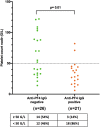Variable serotonin release assay pattern and specificity of PF4-specific antibodies in HIT, and clinical relevance
- PMID: 35971886
- PMCID: PMC9826218
- DOI: 10.1111/jth.15848
Variable serotonin release assay pattern and specificity of PF4-specific antibodies in HIT, and clinical relevance
Abstract
Background: The diagnosis of heparin-induced thrombocytopenia (HIT) requires functional assays to demonstrate that platelet factor 4 (PF4)-specific antibodies activate platelets, typically when therapeutic heparin (H) concentrations are tested ("classical" pattern). Some HIT samples also activate platelets without heparin ("atypical" pattern), but with unclear clinical significance.
Objectives: We aimed to assess whether platelet activation pattern and some characteristics of PF4-specific antibodies were associated with the severity of HIT.
Patients/methods: Serotonin release assay (SRA) pattern of 81 HIT patients were analyzed and compared with their clinical and biological data, including levels of anti-PF4/H immunoglobulin G (IgG) and anti-PF4 IgG in 47 of them.
Results: Higher anti-PF4/H IgG titers were measured in patients with an "atypical" SRA (optical density 2.52 vs. 1.94 in those with a "classical" pattern, p < .001). Patients of both groups had similar platelet count (PC) nadir and time to recovery, but those with an "atypical" SRA more frequently developed thrombotic events (69% vs. 34%, p = .037). Significant levels of anti-PF4 IgG were detected in both groups (38% and 61%, respectively). Whatever the SRA pattern, a lower PC nadir (35 vs. 53 G/L, p = .006) and a longer PC recovery time (6 vs. 3 days, p = .015) were evidenced in patients with anti-PF4 antibodies, compared with those with anti-PF4/H IgG only.
Conclusions: An atypical SRA pattern with elevated anti-PF4/H IgG titers seems associated with an increased risk of thrombosis in HIT. IgG antibodies to native PF4 may contribute to more severe and persistent thrombocytopenia, and their detection could be useful in clinical practice.
Keywords: antibody; platelet factor 4; platelets; serotonin release assay; thrombocytopenia; thrombosis.
© 2022 The Authors. Journal of Thrombosis and Haemostasis published by Wiley Periodicals LLC on behalf of International Society on Thrombosis and Haemostasis.
Conflict of interest statement
J.R. reports a research grant from Stago. Y.G. reports a research grant and symposium fees from Stago. C.P. reports a research grant from Stago. N.C. is currently an employee of Stago. All other authors of this paper have no conflicts of interest.
Figures



References
-
- Greinacher A, Alban S, Omer‐Adam MA, Weitschies W, Warkentin TE. Heparin‐induced thrombocytopenia: a stoichiometry‐based model to explain the differing immunogenicities of unfractionated heparin, low‐molecular‐weight heparin, and fondaparinux in different clinical settings. Thromb Res. 2008;122:211‐220. doi:10.1016/j.thromres.2007.11.007 - DOI - PubMed
-
- Warkentin TE, Kelton JG. Delayed‐onset heparin‐induced thrombocytopenia and thrombosis. Ann Intern Med. 2001;135:502‐506. - PubMed
Publication types
MeSH terms
Substances
LinkOut - more resources
Full Text Sources
Medical
Miscellaneous

